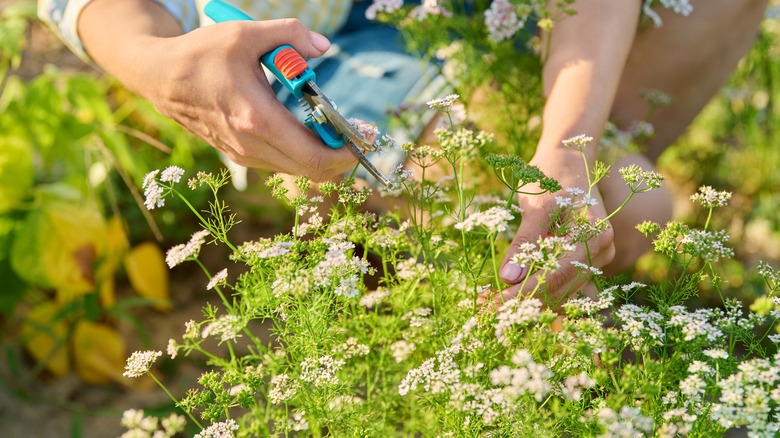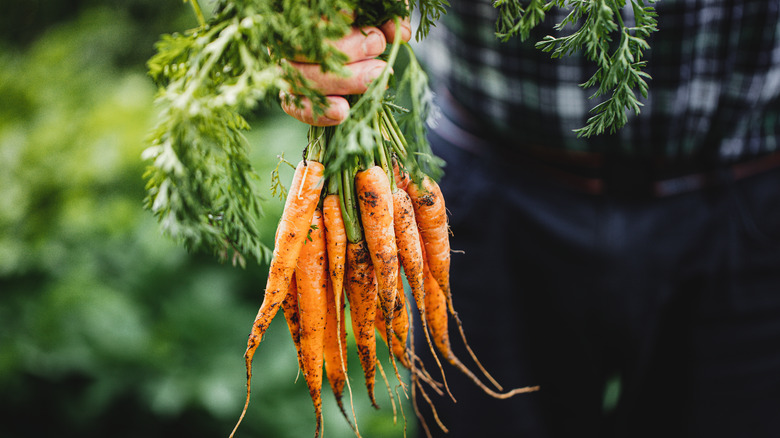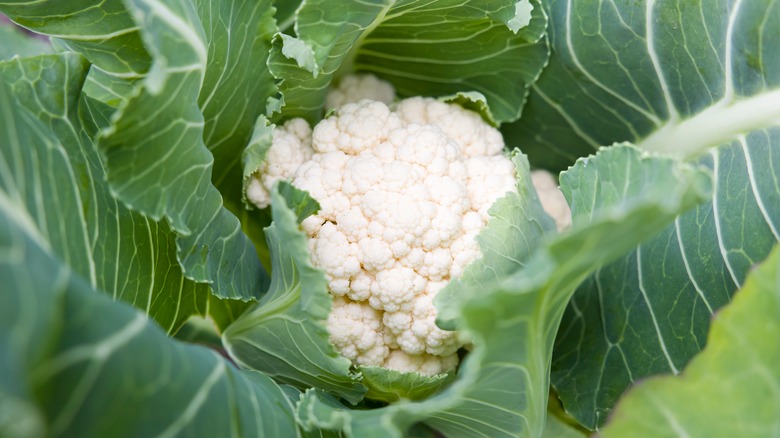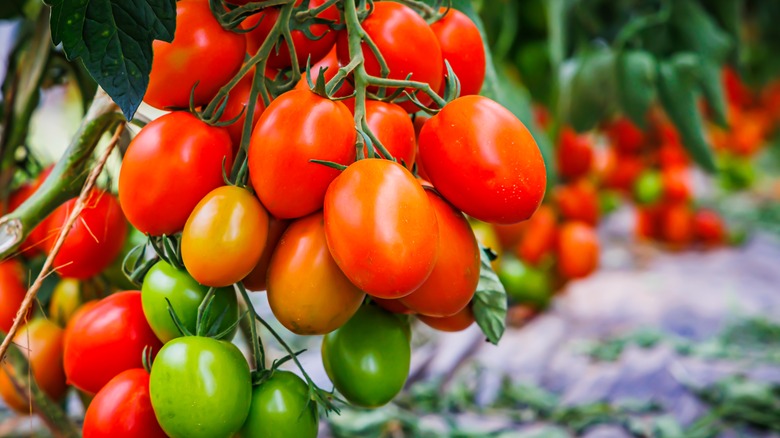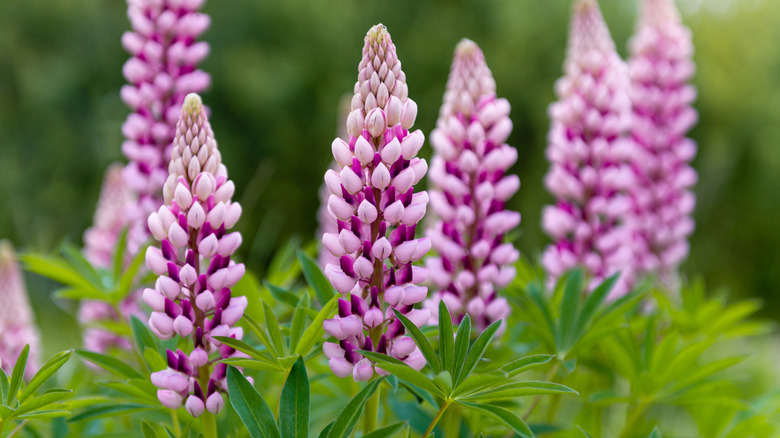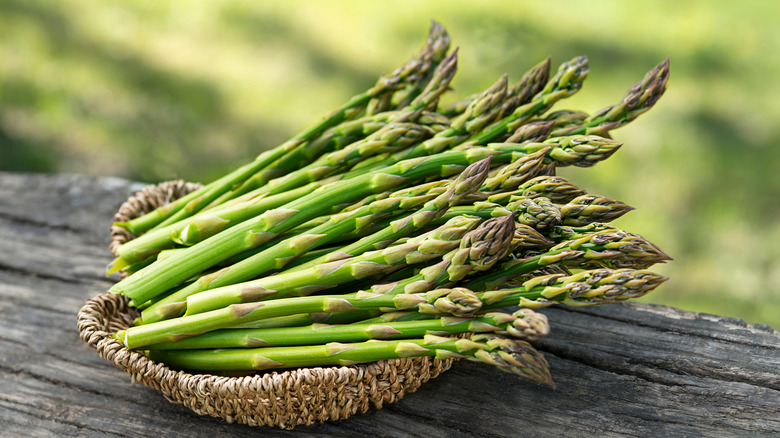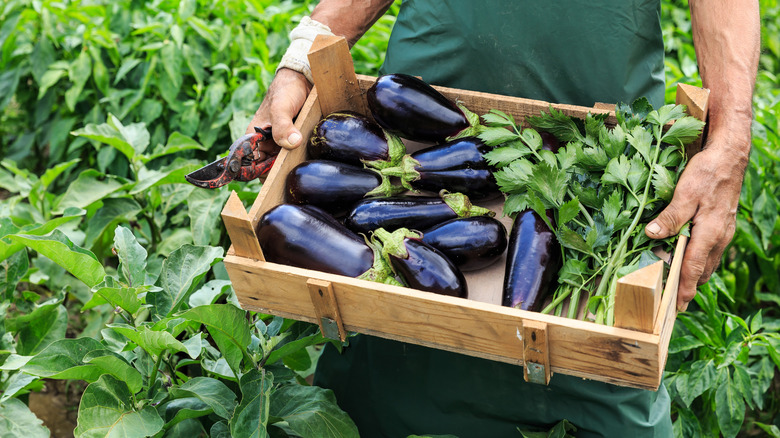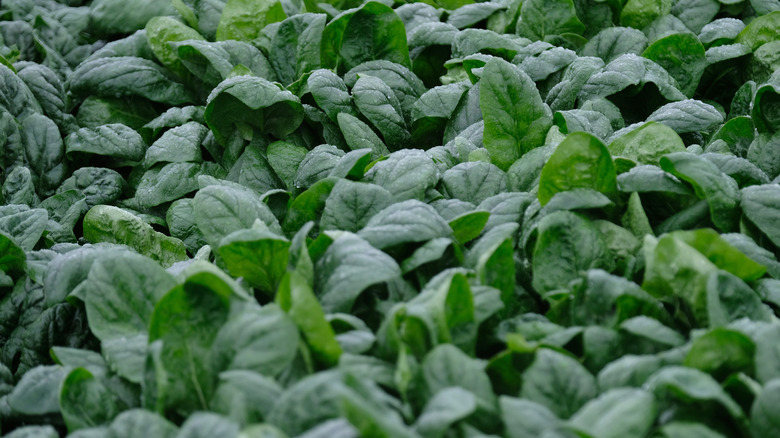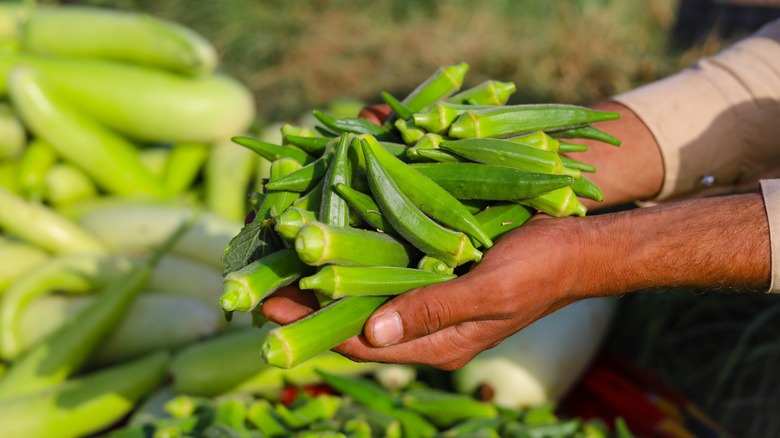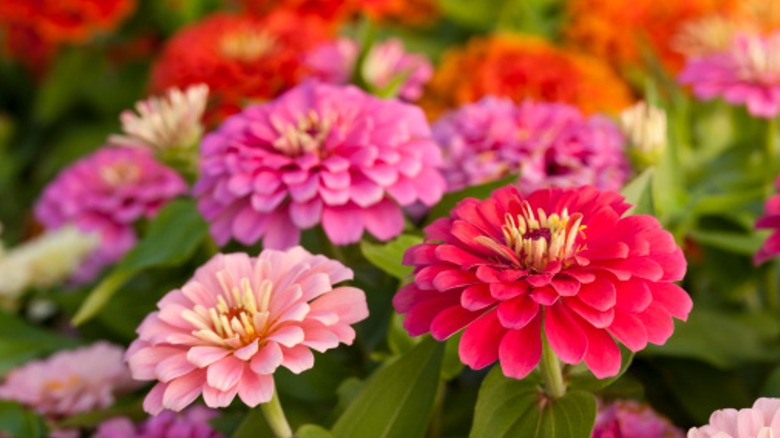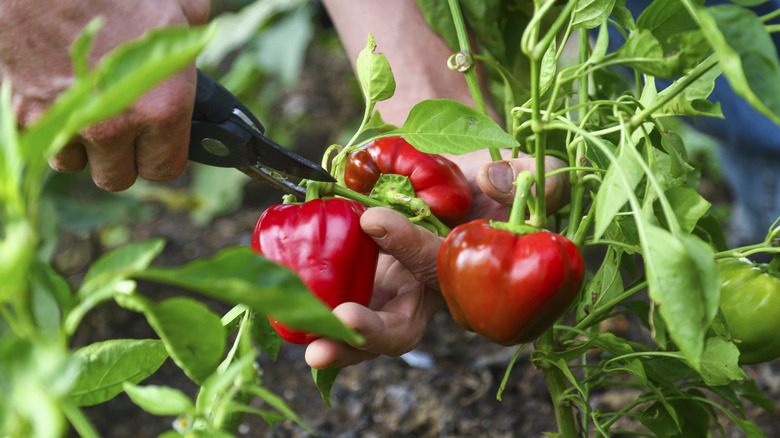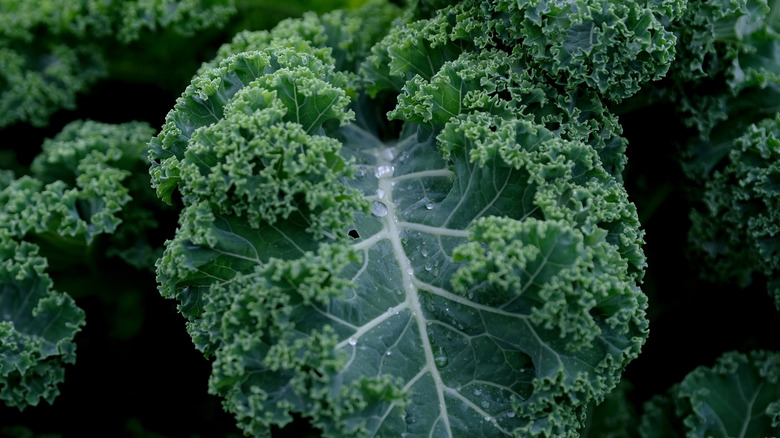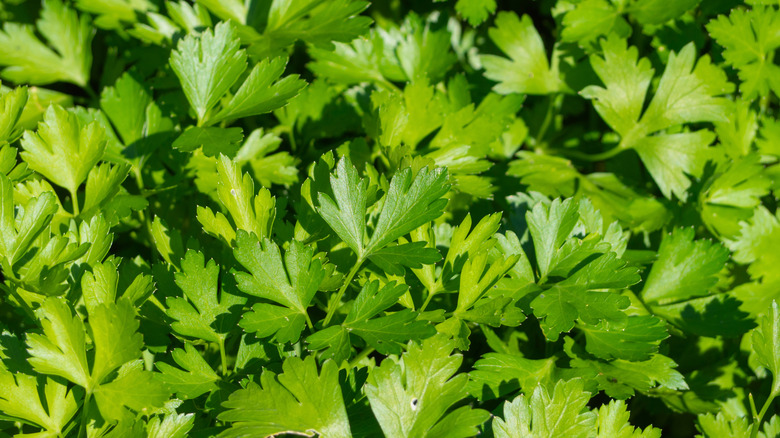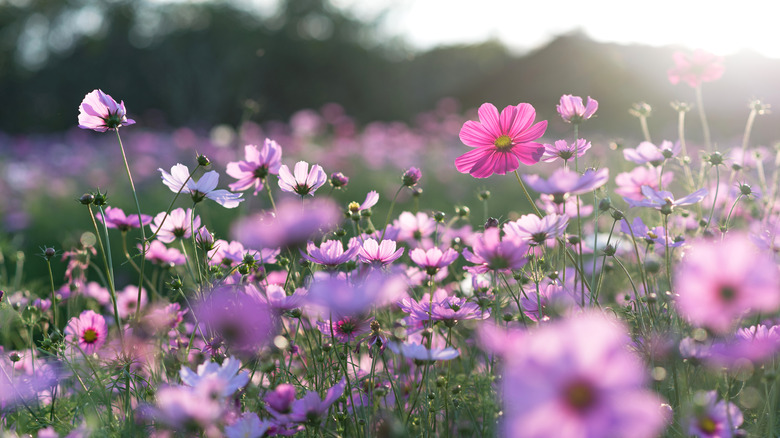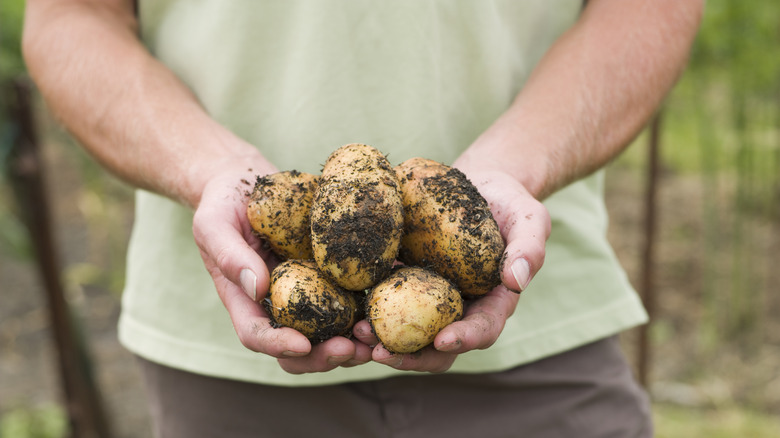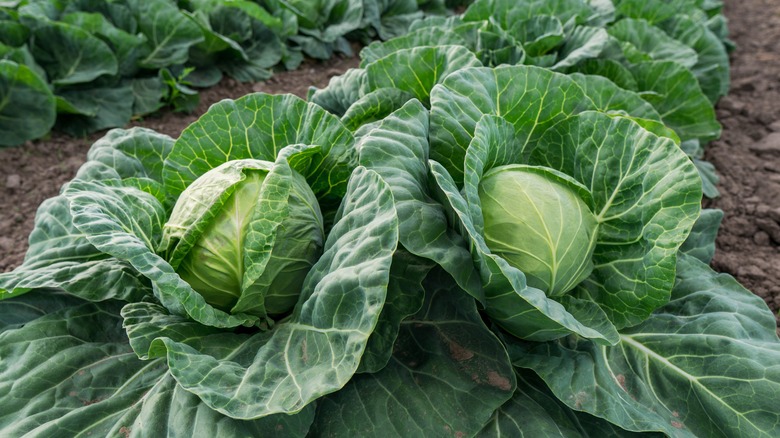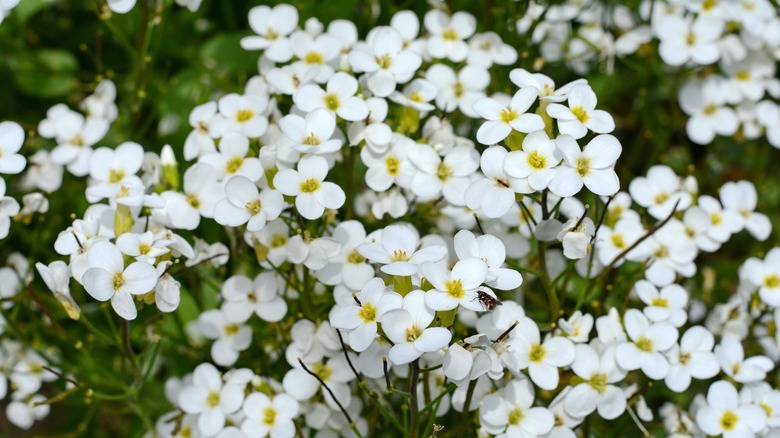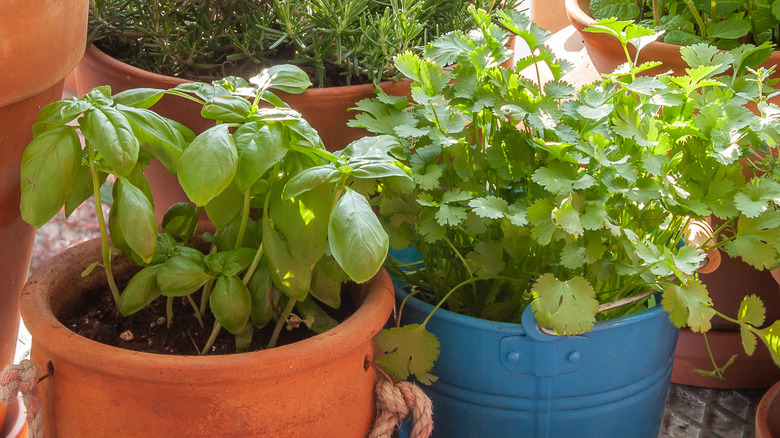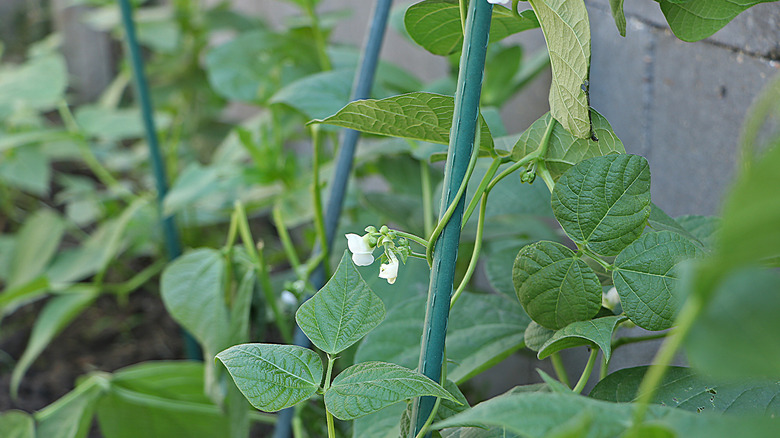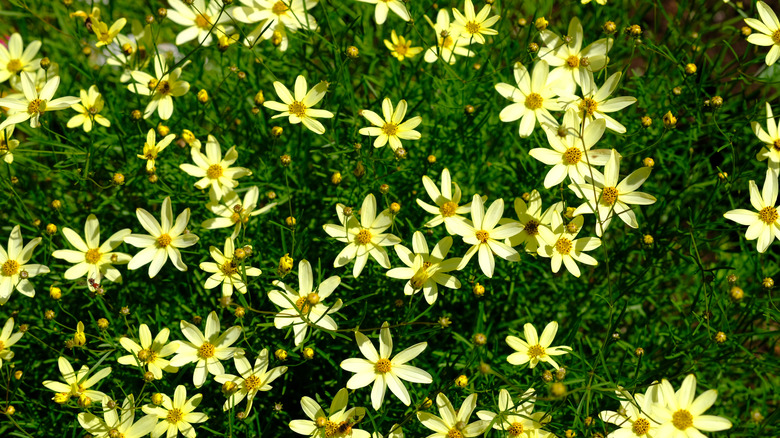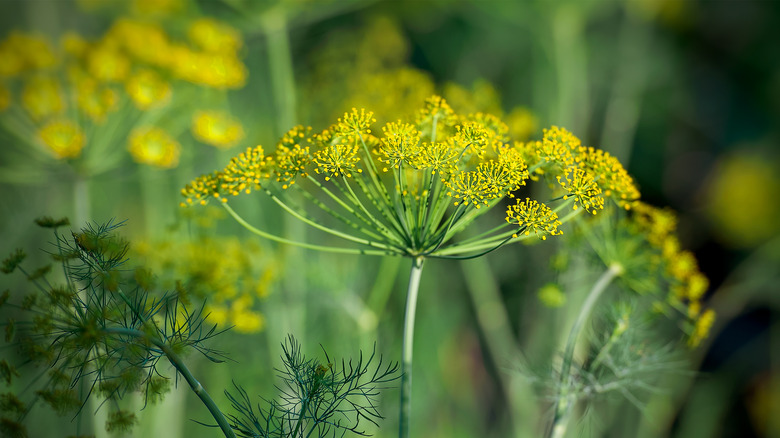Companion Plants That Will Totally Thrive Next To Your Flourishing Cilantro
Herbs tend to be the easiest types of plants to find companions for, and cilantro (Coriandrum sativum) isn't any different. The plant already has so many natural abilities that it needs almost no help in the garden. In fact, cilantro is usually the one to offer some of its benefits to other plants growing near it. It can provide shade, entice pollinators, and it has simple growing requirements that allow it to adapt to different climates. What it can't live without is access to direct sunlight and well-draining soil.
The best reason to plant cilantro in a vegetable garden is because it attracts predatory insects. While the name sounds a bit frightening, these are just pollinators and other bugs that feed on the larvae of other insect species that threaten your edible plants. You're likely already familiar with many of them such as ladybugs, green lacewings, and parasitic wasps. Caring for your cilantro correctly and carefully considering the best place to plant it will reward you with a healthier garden throughout the growing season.
1. Carrots
Carrots (Daucus carota var. sativus) are one of a few root vegetables that benefit from being grown next to cilantro. As we know, cilantro repels a variety of pests, including carrot rust flies, which are attacked by predatory insects that the herb attracts. Planted in the garden, these two edible plants tolerate growing side by side. Both enjoy bright direct sunlight and well-draining soil.
Bloom Season: Summer
USDA Growing Zone: 2 to 11
Growing Conditions: Full sun
Soil Type: Loose, fertile, and well-draining
Size: 3 inches to 3 feet tall and wide
2. Cauliflower
Most Brassica species, such as cauliflower (Brassica oleracea, Botrytis group) are recommended for planting next to cilantro. This is because cilantro is an umbellifer that produces clusters of small flowers in a shape that resembles an umbrella. These flower structures are extremely attractive to beneficial insects that get to work eliminating leaf-eating pests that threaten your cauliflower.
Bloom Season: Spring to fall
USDA Growing Zone: 2 to 11
Growing Conditions: Full sun
Soil Type: Rich, moist, and loam-based
Size: 1 to 2 feet tall and wide
3. Tomatoes
Tomatoes (Solanum lycopersicum) aren't only a great partner for cilantro when mixed together in a top-notch salsa. The two actually pair well together from the beginning of their existence. Planted as neighbors, tomatoes and cilantro have a mutually beneficial relationship as the herb controls the pest population around them, and the tomato plant's tall growth shades the cilantro from the worst of the hot summer sun.
Bloom Season: Summer
USDA Growing Zone: 10 to 11
Growing Conditions: Full sun
Soil Type: Moist, deep, fertile, and well-draining
Size: 3 to 6 feet tall and 2 to 3 feet wide
4. Lupines
If you're looking to make your cilantro plant more ornamental than it is in your average herb garden, choose Lupines (Lupinus spp.) as a companion plant. Lupines are cool weather-loving flowers that have the ability to add nitrogen to the soil, just like legumes. The flowers will help you grow plenty of delicious stems for your cilantro pesto or vinaigrette.
Bloom Season: Spring to summer
USDA Growing Zone: 4 to 8
Growing Conditions: Full sun to partial shade
Soil Type: Well-draining
Size: 1 to 3 feet tall and 2 to 3 feet wide
5. Asparagus
Asparagus (Asparagus officinalis) and cilantro are happy to grow next to each other. They won't compete with each other for space or nutrients and the pungent herb will protect both from harmful insects. Planted in a vegetable garden, asparagus simply needs direct sunlight, rich soil, and regular watering to produce its delicious green shoots in the spring.
Bloom Season: Insignificant flowers in spring and summer
USDA Growing Zone: 3 to 10
Growing Conditions: Full sun
Soil Type: Organically rich and well-draining
Size: 3 to 4 feet tall and 1 to 2 feet wide
6. Eggplants
Eggplants (Solanum melongena) are warm-weather fruiting plants that are a part of the nightshade family along with tomatoes and potatoes. Like these other two nightshades, eggplants enjoy being planted alongside cilantro for its pest-repellent properties. The flowers of cilantro attract predatory insects that eat the larvae of common eggplant foes such as Colorado potato beetles and flea beetles.
Bloom Season: Spring and summer
USDA Growing Zone: 9 to 12
Growing Conditions: Full sun
Soil Type: Fertile, moist, and well-draining
Size: 1 to 4 feet tall and wide
7. Spinach
Like cauliflower, the leaves of spinach plants (Spinacia oleracea) are highly attractive to pests. To keep them out of your garden you can plant cilantro nearby to help ward off many of them. Grow your spinach plants in well-draining and moist soil, which cilantro will thrive in too. They perform best when they receive plenty of direct sunlight and some fertilizer only a couple of times during the growing season.
Bloom Season: Summer
USDA Growing Zone: 2 to 11
Growing Conditions: Full sun to partial shade
Soil type: Rich and well-draining
Size: 6 to 12 inches tall and wide
8. Okra
Okra (Abelmoschus esculentus) is a tall-growing plant that blooms with big and bright flowers, however, it is usually grown for its edible fruits that can be roasted, fried, or boiled. Typically okra plants don't require too much help in the garden unless you have a pest infestation. To combat this, you can plant your okra nearby fragrant herbs, like cilantro, to attract beneficial insects.
Bloom Season: Spring to fall
USDA Growing Zone: 2 to 11
Growing Conditions: Full sun
Soil Type: Moist, fertile, and well-draining
Size: 3 to 5 feet tall and wide
9. Zinnias
Zinnias (Zinnia spp.) are known for their varieties that have different heights, bloom types, petal colors, and tolerances to certain growing conditions. When choosing one to plant alongside your cilantro, we recommend any that grows taller than cilantro's average height of 1 to 2 feet tall. This ensures that your cilantro will get some shade during the growing season while your zinnias soak in all the heat.
Bloom Season: Spring to fall
USDA Growing Zone: 3 to 10
Growing Conditions: Full sun
Soil Type: Moist and well-draining
Size: 8 to 48 inches tall and 6 to 18 inches wide
10. Peppers
Another nightshade species, pepper plants (Capsicum annuum) benefit from the presence of cilantro plants nearby as they deter common pepper threats. In the summer, your cilantro should go to flower just as the peppers start fruiting. So, beneficial bugs, like hoverflies and ladybugs, arrive to feed on nectar and pollen as well as pest larvae from aphids and mites.
Bloom Season: Summer
USDA Growing Zone: 9 to 11
Growing Conditions: Full sun
Soil Type: Moist and well-draining
Size: 6 to 60 inches tall
11. Kale
Kale (Brassica oleracea, Acephala Group) is an annual leafy vegetable that grows best in well-draining and rich soil, like cilantro. As you may have already guessed, kale benefits from cilantro's pest-eating pollinators that come to its clusters of flowers. However, cilantro benefits from kale in other ways too. For example, because it typically grows taller than the salad ingredient, cilantro will shade it from the hot sun with its terminal umbels and dense foliage.
USDA Growing Zone: 2 to 11
Growing Conditions: Full sun to partial shade
Soil Type: Rich, moist, and well-draining
Size: 1 to 2 feet tall
12. Parsley
Though neither brings anything new to the table, parsley (Petroselinum crispum) and cilantro are a really awesome pair. The two have incredibly similar growing requirements, yet they won't fight for nutrients, space, or extra water. When planting, make sure that their soil is evenly moist, rich, and well-draining to see the best results.
Bloom Season: Summer
USDA Growing Zone: 3 to 9
Growing Conditions: Full sun
Soil Type: Rich and well-draining
Size: 12 to 18 inches tall
13. Cosmos
Similarly to zinnias, cosmo flowers (Cosmos bipinnatus) are tall-growing and long bloomers that thrive next to cilantro plants. Their thin stems and thread-like leaves make it possible for the herb to grow in more indirect sunlight, which keeps cilantro from bolting and becoming bitter. Keep in mind that cosmos and cilantro are annuals, so both will need to self-seed or be replanted each year.
Bloom Season: Summer to fall
USDA Growing Zone: 2 to 11
Growing Conditions: Full sun
Soil Type: Evenly moist and well-draining
Size: 1 to 4 feet tall and 2 to 3 feet wide
14. Potatoes
Potato plants (Solanum tuberosum) are an unsurprising addition to this collection. Cilantro is known for deterring one of the potato's most notorious pests: Colorado potato beetles. By planting cilantro close to these plants, they will recruit ladybugs that are happy to eat the beetle larvae to put a stop to an infestation on your potatoes.
Bloom Season: Summer and fall
USDA Growing Zone: 2 to 11
Growing Conditions: Full sun
Soil Type: Evenly moist and well-draining
Size: 1 to 2 feet tall and wide
15. Cabbage
Cabbage (Brassica oleracea var. capitata) is a well-known leafy vegetable that prefers direct sunlight and cool temperatures. Because of this, it usually isn't planted for summer growth as it would suffer under the heat. Instead, it's grown in the early part of spring or in the fall as the temperatures drop. Planted with cilantro, many of the beetles and aphids that feast on cabbage can be dealt with naturally.
Bloom Season: Rarely flowers
USDA Growing Zone: 2 to 11
Growing Conditions: Full sun
Soil Type: Rich, moist, and well-draining
Size: 1 to 2 feet tall and wide
16. Sweet alyssum
Sweet alyssum (Lobularia maritima) is another umbellifer like cilantro. It produces clusters of small flowers in a variety of shades including pink, white, purple, and bicolor varieties. Planting these two together won't exactly help either of the plants because they are so similar, but they will help the rest of your garden as they repel harmful insects, attract pollinators, and beautify the space.
Bloom Season: Spring to fall
USDA Growing Zone: 5 to 9
Growing Conditions: Full sun to partial shade
Soil Type: Well-draining
Size: 3 to 9 inches tall
17. Basil
Basil (Ocimum basilicum) and cilantro are both easy-to-grow herbs with nearly identical growing requirements. Planting the two as neighbors only makes it easier to care for the other. Additionally, each of them is heavily scented with a fragrance that attracts beneficial bugs and repels threatening ones. Try them together in an herb or vegetable garden to see how the power couple performs.
Bloom Season: Summer to fall
USDA Growing Zone: 2 to 11
Growing Conditions: Full sun
Soil Type: Rich and well-draining
Size: 2 feet tall and wide
18. Pole beans
Legumes, such as pole beans (Phaseolus coccineus), fix nitrogen in the soil much like flowers in the Lupinus genus. Cilantro needs nitrogen in its soil to grow its tasty leaves and lots of them. When you plant pole beans nearby, they add this element to the soil for your cilantro. As you care for both, the herb will thrive without the need for fertilizer.
Bloom Season: Summer to fall
USDA Growing Zone: 7 to 11
Growing Conditions: Full sun
Soil Type: Moist and well-draining
Size: 8 to 13 feet tall
19. Threadleaf coreopsis
Threadleaf coreopsis (Coreopsis verticillata) can help cilantro and other plants in your garden grow more healthily. The flowering species give way to yellow flowers that are favored by pollinators. It also has thread-like foliage that casts the perfect amount of shade on the slightly shorter cilantro plant. Thankfully, threadleaf coreopsis can adapt to the herbs' needs too, as it is tolerant of a range of growing conditions.
Bloom Season: Summer to fall
USDA Growing Zone: 3 to 9
Growing Conditions: Full sun
Soil Type: Well-draining
Size: 2 to 3 feet tall and 1 to 2 feet wide
20. Dill
Dill (Anethum graveolens) is among one of the best-known umbellifers. In the summer, the dill plant shoots up tall stems reaching up to 4 feet tall that show off itty bitty yellow flowers in a thick firework-like cluster. Grown alongside cilantro, the two herbs work together to minimize the pest population in a garden.
Bloom Season: Summer
USDA Growing Zone: 2 to 11
Growing Conditions: Full sun
Soil Type: Rich and well-draining
Size: 18 inches to 4 feet tall
